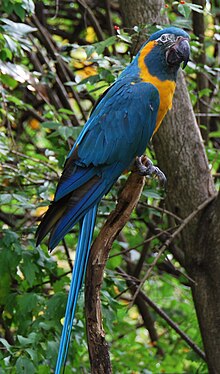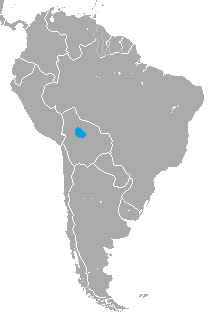Blue-throated macaw
| Blue-throated macaw | |
|---|---|
 |
|
| At Cincinnati Zoo and Botanical Garden, Ohio, USA | |
| Scientific classification | |
| Kingdom: | Animalia |
| Phylum: | Chordata |
| Class: | Aves |
| Order: | Psittaciformes |
| Superfamily: | Psittacoidea |
| Family: | Psittacidae |
| Subfamily: | Arinae |
| Tribe: | Arini |
| Genus: | Ara |
| Species: | Ara glaucogularis |
| Binomial name | |
|
Ara glaucogularis Dabbene, 1921 |
|
 |
|
| Distribution range | |
The blue-throated macaw (Ara glaucogularis; previously Ara caninde), also known as the Caninde macaw or Wagler's macaw, is a macaw endemic to a small area of north-central Bolivia, known as Los Llanos de Moxos, this species is cultural heritage of Bolivia, Recent population and range estimates suggests that about 350–400 individuals remain in the wild. The main causes of their demise is capture for the pet trade. It is currently considered critically endangered and the parrot is protected by trading prohibitions.
The blue-throated macaw is about 85 cm (33 in) long including the length of its tail feathers and has a wingspan of approximately three feet or 0.9 m. It weighs about 900 g (32 oz) to 1,100 g (39 oz). There is little easily observable sexual dimorphism; however, males tend to be a little bigger than females with approximate masses of 750 g and 950 g respectively. Upperparts are turquoise-blue, slightly duller on crown and brighter on rump. Underparts largely bright yellow but the vent is pale blue. It has bare facial patch obscured by blue feather-lines merging into blue lower cheek and throat, separated from crown by narrow yellow stripe and bare pink skin around base of the large, black bill. On the face there is a sparsely feathered patch of skin near the base of the large dark-colored bill that has 5 or 6 horizontal stripes of blue feathers which are unique for every blue-throated macaw and can be used to individually identify adults.
The adults have yellow irises and the juveniles have brown irises. The eye color of a nestling is initially black and changes to brown soon after the eyes open. Between one and three years old, the eyes will turn grey, then white. As the macaw matures, the iris turns yellow and the amount of gold increases with age after 10 years. Elderly macaws show a ring of dark grey surrounding the pupil where the iris has become thinner and the back of the retina shows through. It can be separated from the slightly larger blue-and-yellow macaw by the blue (not black) throat, the blue (not green) crown and the lack of contrast between the remiges and upperwing coverts.
...
Wikipedia

